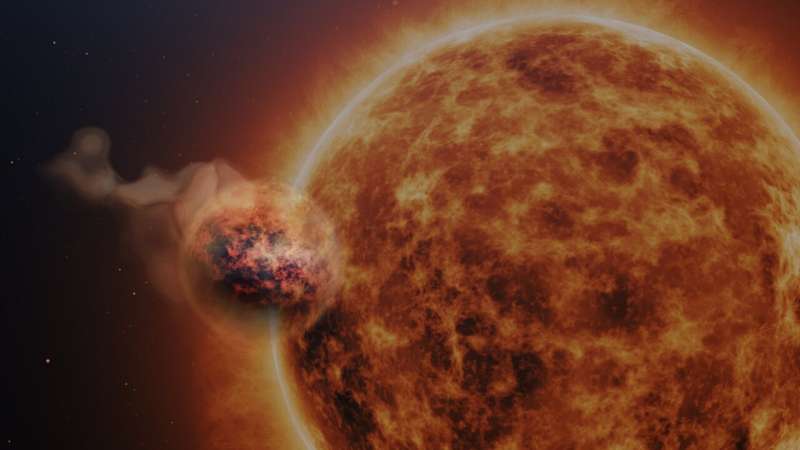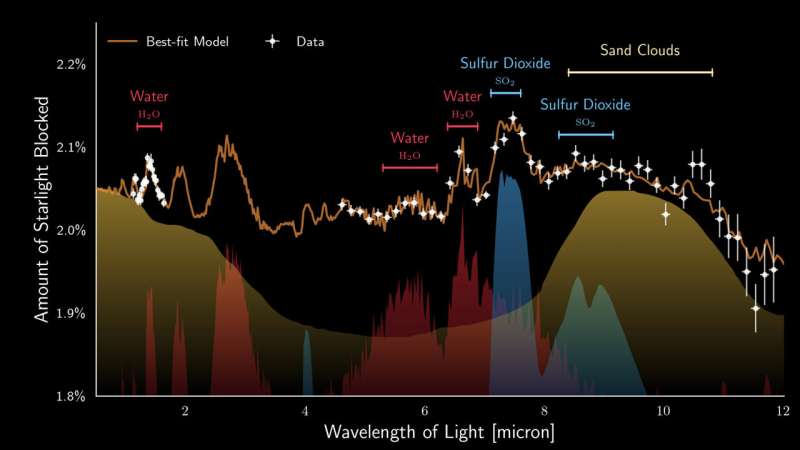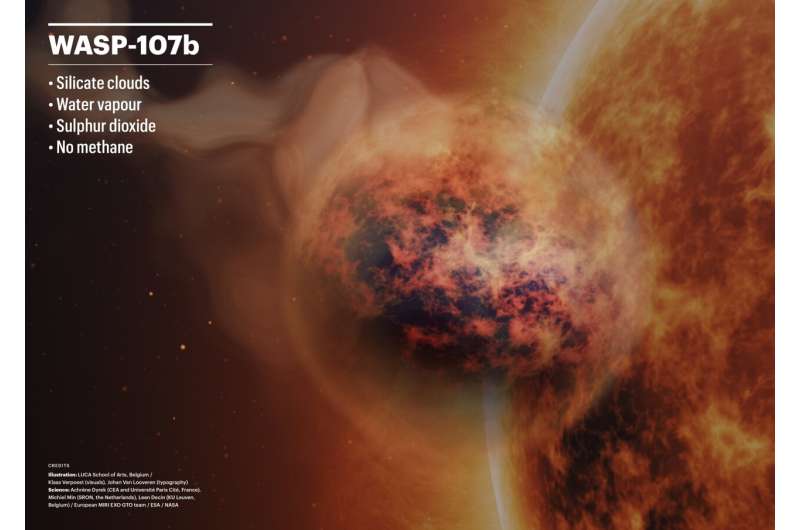This article has been reviewed according to Science X's editorial process and policies. Editors have highlighted the following attributes while ensuring the content's credibility:
fact-checked
peer-reviewed publication
trusted source
proofread
JWST detects water vapor, sulfur dioxide and sand clouds in the atmosphere of a nearby exoplanet

A team of European astronomers, co-led by researchers from the Institute of Astronomy, KU Leuven, used recent observations made with the James Webb Space Telescope to study the atmosphere of the nearby exoplanet WASP-107b. Peering deep into the fluffy atmosphere of WASP-107b they discovered not only water vapor and sulfur dioxide, but even silicate sand clouds. These particles reside within a dynamic atmosphere that exhibits vigorous transport of material.
Astronomers worldwide are harnessing the advanced capabilities of the Mid-Infrared Instrument (MIRI) aboard the James Webb Space Telescope (JWST) to conduct groundbreaking observations of exoplanets—planets orbiting stars other than our own sun. One of these fascinating worlds is WASP-107b, a unique gaseous exoplanet that orbits a star slightly cooler and less massive than our sun.
The mass of the planet is similar to that of Neptune but its size is much larger than that of Neptune, almost approaching the size of Jupiter. This characteristic renders WASP-107b rather 'fluffy' when compared to the gas giant planets within our solar system. The fluffiness of this exoplanet enables astronomers to look roughly 50 times deeper into its atmosphere compared to the depth of exploration achieved for a solar-system giant like Jupiter.
The team of European astronomers took full advantage of the remarkable fluffiness of this exoplanet, enabling them to look deep into its atmosphere. This opportunity opened a window into unraveling the complex chemical composition of its atmosphere.
The reason behind this is quite straightforward: the signals, or spectral features, are far more prominent in a less dense atmosphere compared to a more compact one. Their recent study, now published in Nature, reveals the presence of water vapor, sulfur dioxide (SO2), and silicate clouds, but notably, there is no trace of the greenhouse gas methane (CH4).
A dynamic atmosphere
These detections provide crucial insights into the dynamics and chemistry of this captivating exoplanet. First, the absence of methane hints at a potentially warm interior, offering a tantalizing glimpse into the movement of heat energy in the planet's atmosphere. Secondly, the discovery of sulfur dioxide (known for the odor of burnt matches), was a major surprise.
Previous models had predicted its absence, but novel climate models of WASP-107b's atmosphere now show that the very fluffiness of WASP-107b accommodates the formation of sulfur dioxide in its atmosphere. Even though its host star emits a relatively small fraction of high-energy photons due to its cooler nature, these photons can reach deep into the planet's atmosphere thanks to its fluffy nature. This enables the chemical reactions required to produce sulfur dioxide to occur.

But that's not all they've observed. Both the spectral features of sulfur dioxide and water vapor are significantly diminished compared to what they would be in a cloudless scenario. High-altitude clouds partially obscure the water vapor and sulfur dioxide in the atmosphere.
While clouds have been inferred on other exoplanets, this marks the first instance where astronomers can definitively identify the chemical composition of these clouds. In this case, the clouds consist of small silicate particles, a familiar substance for humans found in many parts of the world as the primary constituent of sand.
"JWST is revolutionizing exoplanet characterization, providing unprecedented insights at remarkable speed," says lead author Prof. Leen Decin of KU Leuven. "The discovery of clouds of sand, water, and sulfur dioxide on this fluffy exoplanet by JWST's MIRI instrument is a pivotal milestone. It reshapes our understanding of planetary formation and evolution, shedding new light on our own solar system."
In contrast to Earth's atmosphere, where water freezes at low temperatures, in gaseous planets reaching temperatures around 1000 degrees Celsius, silicate particles can freeze out to form clouds. However, in the case of WASP-107b, with a temperature of around 500 degrees Celsius in the outer atmosphere, traditional models predicted that these silicate clouds should be forming deeper within the atmosphere, where temperatures are substantially higher. In addition, sand clouds high up in the atmosphere rain out. How is it then possible that these sand clouds exist at high altitudes and continue to endure?

According to lead author Dr. Michiel Min, "The fact that we see these sand clouds high up in the atmosphere must mean that the sand rain droplets evaporate in deeper, very hot layers and the resulting silicate vapor is efficiently moved back up, where they recondense to form silicate clouds once more. This is very similar to the water vapor and cloud cycle on our own Earth but with droplets made of sand."
This continuous cycle of sublimation and condensation through vertical transport is responsible for the enduring presence of sand clouds in WASP-107b's atmosphere.
This pioneering research not only sheds light on the exotic world of WASP-107b but also pushes the boundaries of our understanding of exoplanetary atmospheres. It marks a significant milestone in exoplanetary exploration, revealing the intricate interplay of chemicals and climatic conditions on these distant worlds.
"JWST enables a deep atmospheric characterization of an exoplanet that does not have any counterpart in our solar system, we are unraveling new worlds," says lead author Dr. Achrène Dyrek at CEA Paris.
Design and development of the MIRI instrument
Belgian engineers and scientists played a key role in the design and development of the MIRI instrument, including the Center Spatial de Liege (CSL), Thales Alenia Space (Charleroi) and OIP Sensor Systems (Oudenaarde). At the Institute of Astronomy at KU Leuven, instrument scientists tested the MIRI instrument extensively in special test chambers simulating the space environment in laboratories in the UK, at NASA Goddard and NASA Johnson Space centers.
"With colleagues across Europe and the United States we have been building and testing the MIRI instrument for almost 20 years. It is rewarding to see our instrument unravel the atmosphere of this intriguing exoplanet," says instrument specialist Dr. Bart Vandenbussche of KU Leuven.
This study combines the results of several independent analyses of the JWST observations, and represents the years of work invested not only in building the MIRI instrument but also in the calibration and analysis tools for the observational data acquired with MIRI," says Dr. Jeroen Bouwman of the Max-Planck-Institut für Astronomie, Germany.
Correction Note (11/16/2023): Dr. Jeroen Bouwman's affiliation has been updated to the Max-Planck-Institut für Astronomie, Germany, for accuracy.
More information: SO2, silicate clouds, but no CH4 detected in a warm Neptune with JWST MIRI, Nature (2023). DOI: 10.1038/s41586-023-06849-0
Journal information: Nature
Provided by KU Leuven





















